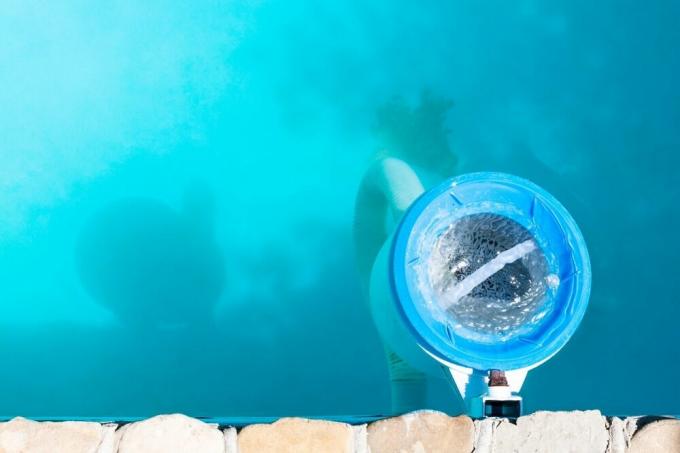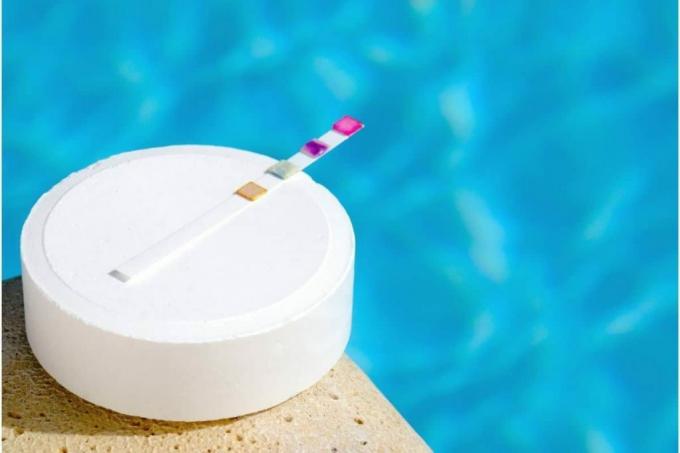
table of contents
- What is a cartridge filter?
- frequency
- Prevention & function
- Preventive measures
- Step by step
- Home remedies
- Frequency of change
- frequently asked Questions
To ensure that summer in the pool is pure pleasure, you have to clean the cartridge filter - regularly and correctly. You can find out how this works in the following guide.
In a nutshell
- Cover and landing net are not replaced
- Failure to clean the filter cartridge can damage the pump
- Aids such as vinegar and chlorine are useful
- Cleaning the cartridge filter keeps the water in the pool clear
- with the right instructions, the effort is very little
What is a cartridge filter?
There are different filter variants for a pool. The so-called cartridge filter is very common. In this case, the water is pumped through a cartridge that is lined with a suitable filter medium.
Usually it is fiberglass or a synthetic fabric. In addition to larger impurities and foreign bodies, algae and fine dirt also get stuck in it. As a result, the water offers a less favorable breeding ground for microorganisms, which can also cloud the water and cause streaky deposits on the inner surfaces. Cleaning the cartridge filter and using appropriate tools is therefore of crucial importance.
frequency
Some foreign matter gets into the water during the pool season. For example:
- Earth
- hair
- Dander
- insects
- leaves
- suncream
Regular cleaning is necessary so that this contamination does not lead to clouding, algae growth or even tipping of the water. It is advisable to clean the cartridge filter after the pool has been used for a week or has not been covered.

Prevention & function
Weekly cleaning makes sense in any case, because the cleaner the cartridge filter, the cleaner the water and the less stress on the pump. As the filter medium becomes increasingly clogged, work harder and harder, which can lead to overheating, for example.
However, there are different means and measures that have different advantages. For example:
- lower expense
- low costs
- rare replacement of the filter cartridge
Preventive measures
-
Cover: If the pool is covered when not in use, the pollution is significantly less. Foreign bodies can no longer fly into the water and solar radiation does not contribute to the growth of the algae.
-
Shear off: Removing coarse dirt with a net is quick and quiet but extremely efficient. Leaves, twigs and algae can no longer clog the filter and the filter cartridge, so that the frequency of cleaning can be reduced if necessary.
-
Chlorine: An addition of chlorine in liquid form or as tablets prevents contamination and prevents microorganisms from spreading.
-
matching filter: The filter capacity must match the size and also the frequency of use. A small pool that the whole family spends in every day will pollute faster than a large pool that is only used by one or two people or rarely.
-
correct location: Directly under a tree or close to deciduous bushes and shrubs there is a risk of leaves flying in again and again. These plants are also used by birds and animals, so that pollution from feathers, droppings or the animals themselves can occur.
- To wash: In swimming pools you shouldn't take a shower before bathing for nothing. This prevents excess skin flakes or other elements from being brought in.

Tip: A simple shower of your feet is usually enough. This can make a significant difference, especially for children who romp around the garden barefoot before and after bathing.
Step by step
Cleaning a cartridge filter is very easy if you know the right steps.
-
Turn off and open the filter: Please note the information provided by the manufacturer. The pump must be out of operation and disconnected from the power supply. The cover over the filter cartridge is then removed.
-
Remove cartridge: As a rule, it is sufficient to turn it out of the holder. Again, you should follow the instructions for use.
-
Cleaning: The cartridge is then rinsed out with a garden hose. To do this, we recommend using a garden hose, which is used to flush from the outside in and from the bottom to the top. This dissolves the dirt in the filter medium and can flow out together with the water.
- Soaking: Soaking is an alternative or an additional step. Filter cleaner, a solution of six parts water and one part chlorine or vinegar concentrate can be used for this. As a result, microorganisms die and the subsequent rinsing becomes easier and more thorough.
Note: It is recommended that the cartridge filter be cleaned in the dishwasher again and again. However, this brings with it several problems and should therefore be avoided.

Home remedies
Slightly acidic water offers less attack surface for lime, algae and aquatic organisms. A quantity of 100 milliliters per cubic meter of water is enough to protect the filter. Alternatively, chlorine can be used.
Frequency of change
Even if you regularly clean the cartridge filter, take additional measures and use resources, the filter medium will eventually be used up and you will have to replace it.
How often this is necessary depends on various factors. These include:
- Type of filter medium
- Degree of pollution
- Frequency of use
As soon as permanent discoloration appears or the filter floss is no longer permeable enough, it should be changed. With heavy use, this can be the case once a month. In other circumstances it is sufficient to change once per season.
frequently asked Questions
Yes, for example a sand filter. Here the sand is the main filter medium. It must also be flushed through and therefore cleaned regularly. The effort is therefore comparatively similar.
If there is already heavy pollution, then you need to act quickly. Suitable agents are then UV light, chlorine and daily cleaning of the filter. If necessary, the pool must be completely cleaned and the water completely changed.
Because it keeps coarse soiling away and, among other things, prevents animals from drowning in the swimming pool. Even if it obviously means more effort to cover the pool in the evening and in the morning, it saves work, time and money in the long term.

